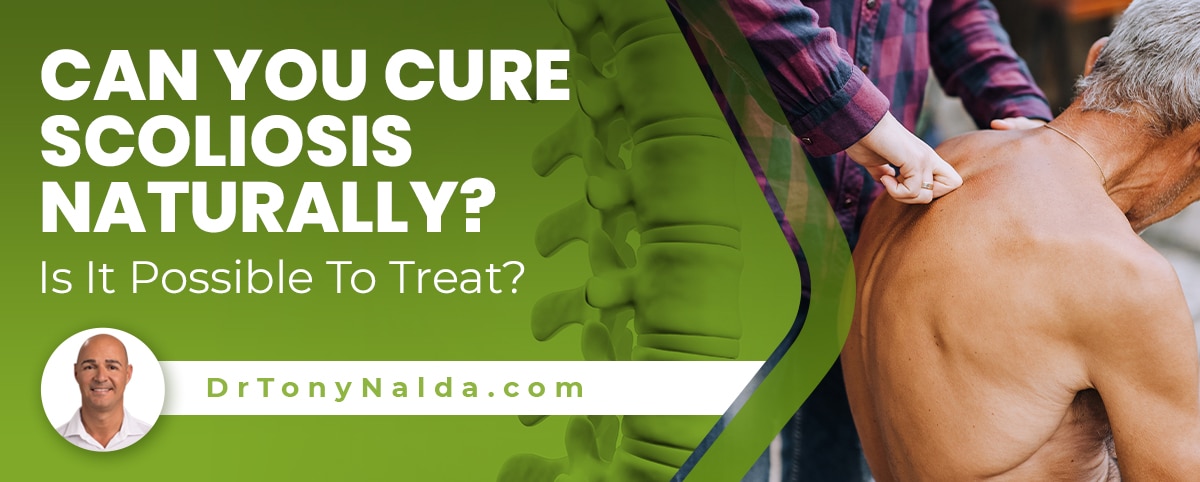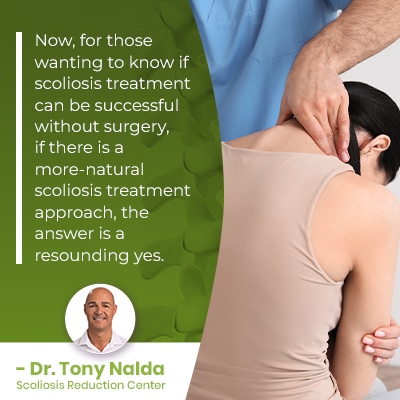Can You Cure Scoliosis Naturally? Is It Possible To Treat?

Scoliosis is a highly-prevalent spinal condition that affects all ages. It ranges widely in severity and is progressive in nature. When it comes to treating scoliosis, patients benefit from having two main treatment approaches to choose between: traditional and conservative. Continue reading to understand the different potential outcomes they offer.
As a progressive condition, there is no curing scoliosis, but it can be highly treatable, particularly when treated proactively. A traditional treatment approach involves spinal fusion surgery, and modern conservative natural treatment provides a non-surgical alternative.
Let's start by addressing the question of whether or not scoliosis can be cured, by exploring what the condition's progressive nature means.
Table of Contents
Curing versus Treating Scoliosis
When people ask if a condition can be cured naturally, they can mean different things; to clarify, for our current purposes, curing scoliosis naturally means either a do-it-yourself approach to scoliosis treatment from home, and/or if it be cured without surgical procedures.
While I applaud the initiative to be more proactive with one's own health, there are some conditions that are simply beyond the scope of DIY home treatment, and scoliosis is one of them.
While scoliosis-specific exercises can be researched and performed from home, as a structural spinal condition, scoliosis treatment needs to, first and foremost, impact scoliosis on a structural level.
When a spinal condition is structural, there is a structural abnormality within the spine itself, and no exercise or form of self-treatment can correct a crooked spine alone.
In addition, scoliosis needs to be diagnosed and monitored via X-ray, so unless a person has access to an X-ray machine at home, not to mention the knowledge and experience to comprehensively measure, assess, and interpret the results of a scoliosis X-ray, condition's can't be treated/monitored effectively.
And as one of the most-prevalent complex progressive conditions to affect the spine, scoliosis has it in its very nature to get worse over time, and this means the condition will get more complex to treat.
 This is the difference between curing and treating scoliosis; once diagnosed, scoliosis will be with a person for life, but it can be highly treatable and doesn't have to limit a patient.
This is the difference between curing and treating scoliosis; once diagnosed, scoliosis will be with a person for life, but it can be highly treatable and doesn't have to limit a patient.
Scoliosis is a Progressive Condition
Scoliosis being progressive means it's virtually guaranteed to get worse at some point.
Scoliosis progressing means the size of the unnatural sideways spinal curvature is increasing, and as this occurs, the condition's uneven forces being exposed to the body, and their effects, are also increasing.
In children, the main symptom of scoliosis is postural deviation, and in adults, it's pain that can range from mild and intermittent to debilitating chronic pain, and the best way to reduce scoliosis pain is to treat it proactively.
As a scoliotic curve increases in size, the spine gets more rigid, and this makes it less responsive to treatment; in addition, increasing spinal rigidity can also make it difficult to perform certain therapeutic exercises that are an important facet of treatment.
In patients who have significantly progressed prior to starting treatment, as is often the case with my adult patients, a certain amount of preparatory work has to be done prior to starting the regular course of treatment, in order to restore a baseline level of spinal flexibility.
Scoliosis ranges from mild scoliosis to moderate and severe to very severe, so where a person's scoliosis is when they are diagnosed doesn't mean that's where it will stay, particularly if left untreated, or not treated proactively.
So while there are no treatment guarantees, with scoliosis that's detected early and responded to with a proactive treatment plan, there are fewer limits to what can be achieved.
Now, for those wanting to know if scoliosis treatment can be successful without surgery, if there is a more-natural scoliosis treatment approach, the answer is a resounding yes.
Treating Scoliosis Without Surgery
When it comes to treating scoliosis with surgery, we're talking about spinal fusion surgery, and every patient will respond to the procedure in their own way, but it is a costly, lengthy, and invasive surgery with risks that should be considered carefully.
Spinal fusion surgery generally involves fusing the curve's most-tilted vertebrae into one solid bone and attaching rods to the spine with pedicle screws to hold it in place, and this is done so the most-tilted vertebrae can't become more tilted over time (slowing/stopping progression).
 But how does that affect the spine? Spinal fusion is contrary to the spine's movement-based design, and having a section with vertebrae fused together can mean a significant loss in spinal flexibility and range of motion; this is the main outcome patients are often the most disappointed with.
But how does that affect the spine? Spinal fusion is contrary to the spine's movement-based design, and having a section with vertebrae fused together can mean a significant loss in spinal flexibility and range of motion; this is the main outcome patients are often the most disappointed with.
In addition, a spine that's fused is a spine that's fused for life, and one that's weaker and more vulnerable to injury, and that knowledge can have a psychological effect that shouldn't be ignored; some patients are fearful of trying new things and/or of participating in once-loved physical activities.
When it comes to scoliosis treatment without surgery, a modern conservative treatment approach is chiropractic-centered, and focuses on being proactive by starting treatment as close to the time of diagnosis as possible; traditional treatment commonly recommends watching and waiting until when/if a condition progresses to severe because it doesn't have a strategy for treating scoliosis while mild, and to me, this is wasting valuable treatment time.
Here at the Scoliosis Reduction Center, my patients benefit from a more-natural treatment path that combines multiple forms of condition-specific treatment delivered by an experienced scoliosis specialist.
I integrate different treatment disciplines into treatment plans: chiropractic care, physical therapy, corrective bracing, and rehabilitation.
One of my main goals of treatment is to help patients avoid invasive procedures needed in the future as I feel this gives them the best possible quality of life.
So let's break down each facet of my non-surgical treatment approach.
Chiropractic Care
Condition-specific chiropractic care is the main facet of a conservative scoliosis treatment approach.
Through a series of chiropractic techniques and manual chiropractic adjustments, I can work towards repositioning the most-tilted vertebrae at the apex of the curve, back into alignment with the rest of the spine, thus restoring as much of the spine's natural curves as possible.
Through chiropractic care, I can impact conditions on a structural level, and once I start to see the type of structural results needed, I shift my focus to other facets of treatment so conditions can be impacted in other ways.
Physical Therapy
Condition-specific physical therapy can help treat scoliosis in a number of ways, starting with increasing core strength so the spine can be optimally supported by its surrounding muscles.
Scoliosis can also be associated with a muscle imbalance as the unnatural spinal curvature pulls the spine's surrounding muscles in different directions; the muscles on one side can become weak from underuse, while the muscles on the other side can become stretched and sore from overuse.
Physical therapy can help address a scoliosis-related muscle imbalance by using specific exercises to strengthen weak muscles and stretch and relax over-used ones, and it can also help with improving posture and activating certain areas of the brain for improved brain-body communication.
Corrective Bracing
While a traditional treatment approach also uses bracing, it's associated with a number of shortfalls that limit its potential efficacy; the main one being that traditional braces ignore the condition's rotational component, treating it only as a 2-dimensional condition, instead of the complex 3-dimensional condition that it is.
Corrective bracing like the ScoliBrace represents the culmination of what we've learned about the condition and bracing efficacy over the years and can help by pushing the spine into a corrective position.
Rehabilitation
Rehabilitation is the final and ongoing phase of treatment because, again, as a progressive condition, scoliosis is incurable.
Continued chiropractic care can be needed to hold the curvature reduction, and a series of custom-prescribed scoliosis exercises can help patients establish a home-rehabilitation program to further stabilize and heal the spine.
Conclusion
So can you cure scoliosis naturally? While there is no known cure for scoliosis, it can be highly treatable, and there is a more-natural treatment approach: conservative scoliosis treatment.
The complex nature of scoliosis necessitates the full customization of potentially-effective treatment plans, and through a multifaceted approach, I can apportion different facets of treatment accordingly; through close monitoring via X-ray and physical examinations, I observe how the spine is responding to treatment and adjust plans as needed.
While spinal surgery and traditional methods can help straighten an unnatural curvature of the spine, it can cost the spine in terms of its flexibility and range of motion.
Here at the Center, I respond to a diagnosis of scoliosis by starting treatment as soon as possible because with treatment started early in a condition's progressive line, there are fewer limits to what can be achieved.
By treating scoliosis without surgery, spinal health is preserved, and this can give patients the best possible quality of life throughout treatment and beyond.
While no one type of treatment can impact scoliosis cases on every level as needed, when multiple disciplines are combined to address a condition's underlying cause, a natural approach can be highly effective.
So when it comes to how to fix scoliosis naturally and reverse scoliosis naturally, we're talking about a non-surgical response that is aligned with the spine's natural strength, design, and function.
Dr. Tony Nalda
DOCTOR OF CHIROPRACTIC
After receiving an undergraduate degree in psychology and his Doctorate of Chiropractic from Life University, Dr. Nalda settled in Celebration, Florida and proceeded to build one of Central Florida’s most successful chiropractic clinics.
His experience with patients suffering from scoliosis, and the confusion and frustration they faced, led him to seek a specialty in scoliosis care. In 2006 he completed his Intensive Care Certification from CLEAR Institute, a leading scoliosis educational and certification center.
About Dr. Tony Nalda
 Ready to explore scoliosis treatment? Contact Us Now
Ready to explore scoliosis treatment? Contact Us Now





